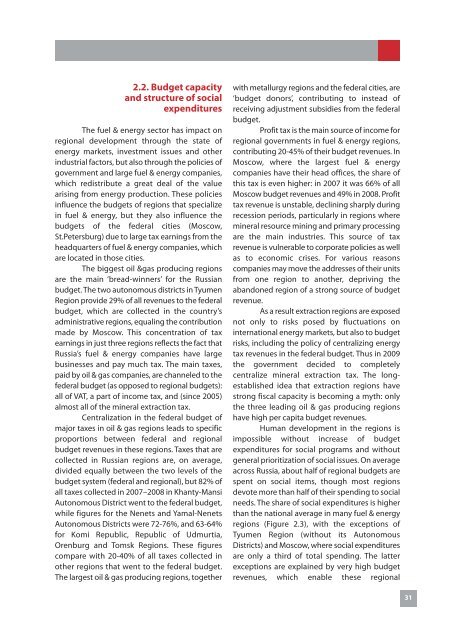Report - UNDP Russia
Report - UNDP Russia
Report - UNDP Russia
Create successful ePaper yourself
Turn your PDF publications into a flip-book with our unique Google optimized e-Paper software.
2.2. Budget capacityand structure of socialexpendituresThe fuel & energy sector has impact onregional development through the state ofenergy markets, investment issues and otherindustrial factors, but also through the policies ofgovernment and large fuel & energy companies,which redistribute a great deal of the valuearising from energy production. These policiesinfluence the budgets of regions that specializein fuel & energy, but they also influence thebudgets of the federal cities (Moscow,St.Petersburg) due to large tax earnings from theheadquarters of fuel & energy companies, whichare located in those cities.The biggest oil &gas producing regionsare the main ‘bread-winners’ for the <strong>Russia</strong>nbudget. The two autonomous districts in TyumenRegion provide 29% of all revenues to the federalbudget, which are collected in the country’sadministrative regions, equaling the contributionmade by Moscow. This concentration of taxearnings in just three regions reflects the fact that<strong>Russia</strong>’s fuel & energy companies have largebusinesses and pay much tax. The main taxes,paid by oil & gas companies, are channeled to thefederal budget (as opposed to regional budgets):all of VAT, a part of income tax, and (since 2005)almost all of the mineral extraction tax.Centralization in the federal budget ofmajor taxes in oil & gas regions leads to specificproportions between federal and regionalbudget revenues in these regions. Taxes that arecollected in <strong>Russia</strong>n regions are, on average,divided equally between the two levels of thebudget system (federal and regional), but 82% ofall taxes collected in 2007–2008 in Khanty-MansiAutonomous District went to the federal budget,while figures for the Nenets and Yamal-NenetsAutonomous Districts were 72-76%, and 63-64%for Komi Republic, Republic of Udmurtia,Orenburg and Tomsk Regions. These figurescompare with 20-40% of all taxes collected inother regions that went to the federal budget.The largest oil & gas producing regions, togetherwith metallurgy regions and the federal cities, are‘budget donors’, contributing to instead ofreceiving adjustment subsidies from the federalbudget.Profit tax is the main source of income forregional governments in fuel & energy regions,contributing 20-45% of their budget revenues. InMoscow, where the largest fuel & energycompanies have their head offices, the share ofthis tax is even higher: in 2007 it was 66% of allMoscow budget revenues and 49% in 2008. Profittax revenue is unstable, declining sharply duringrecession periods, particularly in regions wheremineral resource mining and primary processingare the main industries. This source of taxrevenue is vulnerable to corporate policies as wellas to economic crises. For various reasonscompanies may move the addresses of their unitsfrom one region to another, depriving theabandoned region of a strong source of budgetrevenue.As a result extraction regions are exposednot only to risks posed by fluctuations oninternational energy markets, but also to budgetrisks, including the policy of centralizing energytax revenues in the federal budget. Thus in 2009the government decided to completelycentralize mineral extraction tax. The longestablishedidea that extraction regions havestrong fiscal capacity is becoming a myth: onlythe three leading oil & gas producing regionshave high per capita budget revenues.Human development in the regions isimpossible without increase of budgetexpenditures for social programs and withoutgeneral prioritization of social issues. On averageacross <strong>Russia</strong>, about half of regional budgets arespent on social items, though most regionsdevote more than half of their spending to socialneeds. The share of social expenditures is higherthan the national average in many fuel & energyregions (Figure 2.3), with the exceptions ofTyumen Region (without its AutonomousDistricts) and Moscow, where social expendituresare only a third of total spending. The latterexceptions are explained by very high budgetrevenues, which enable these regional31












